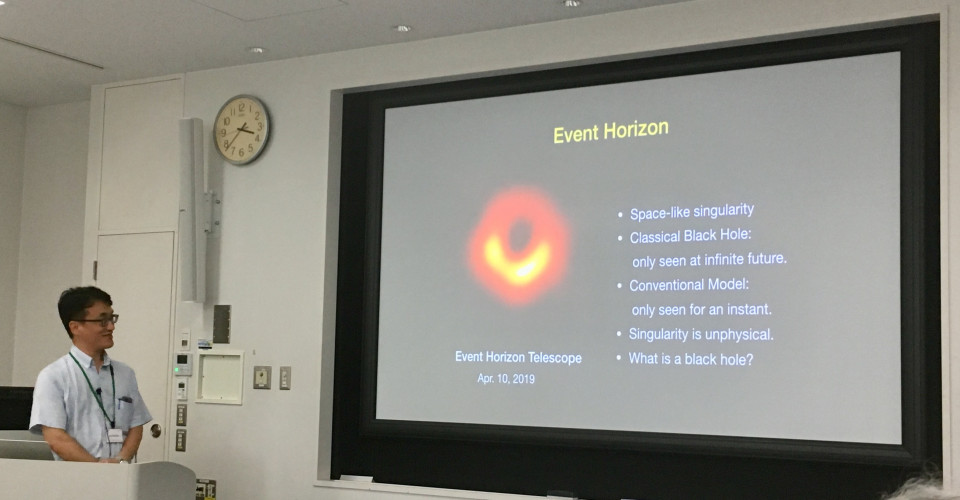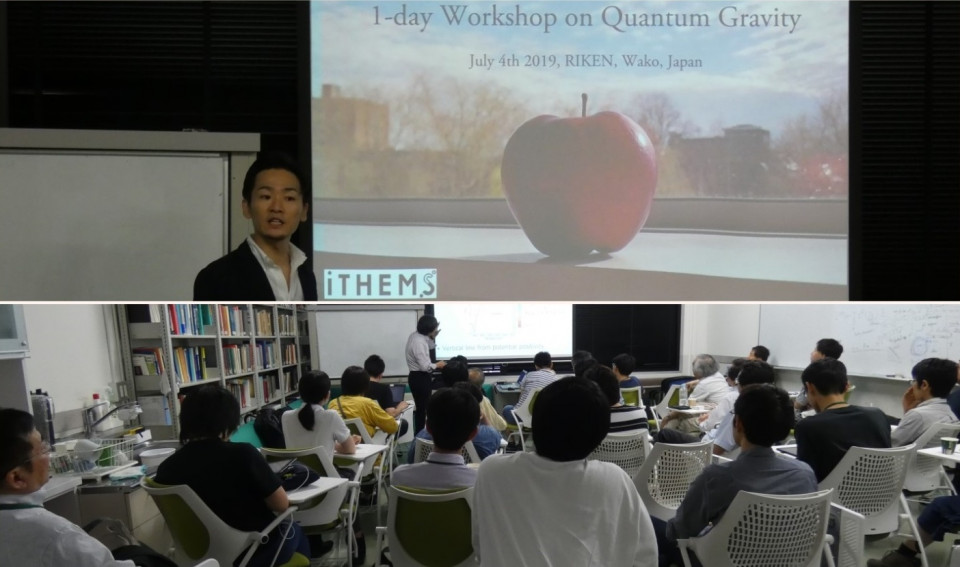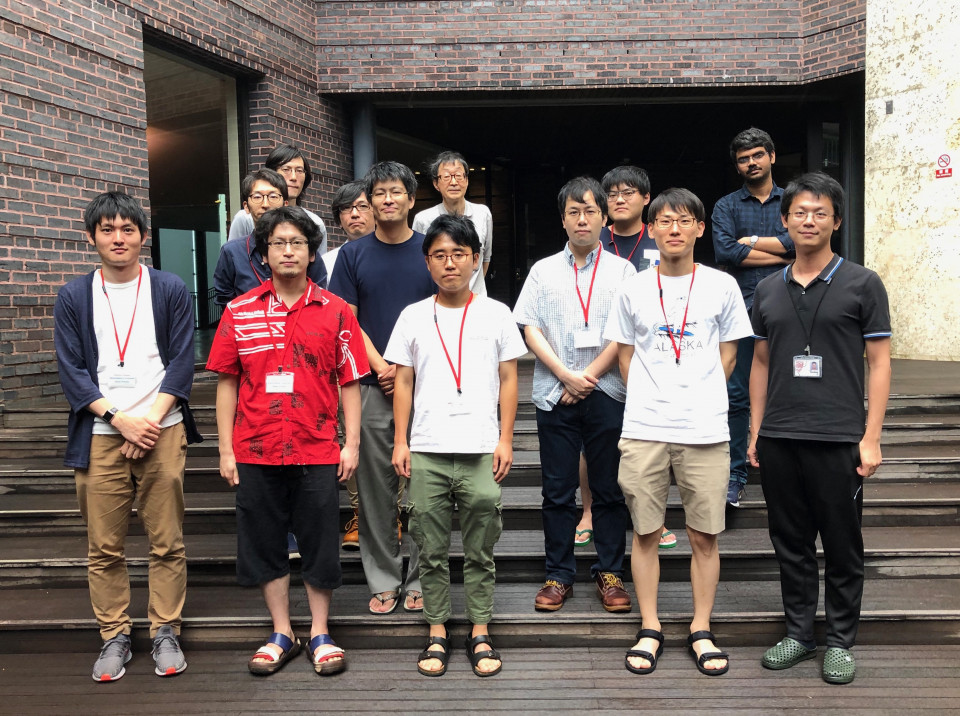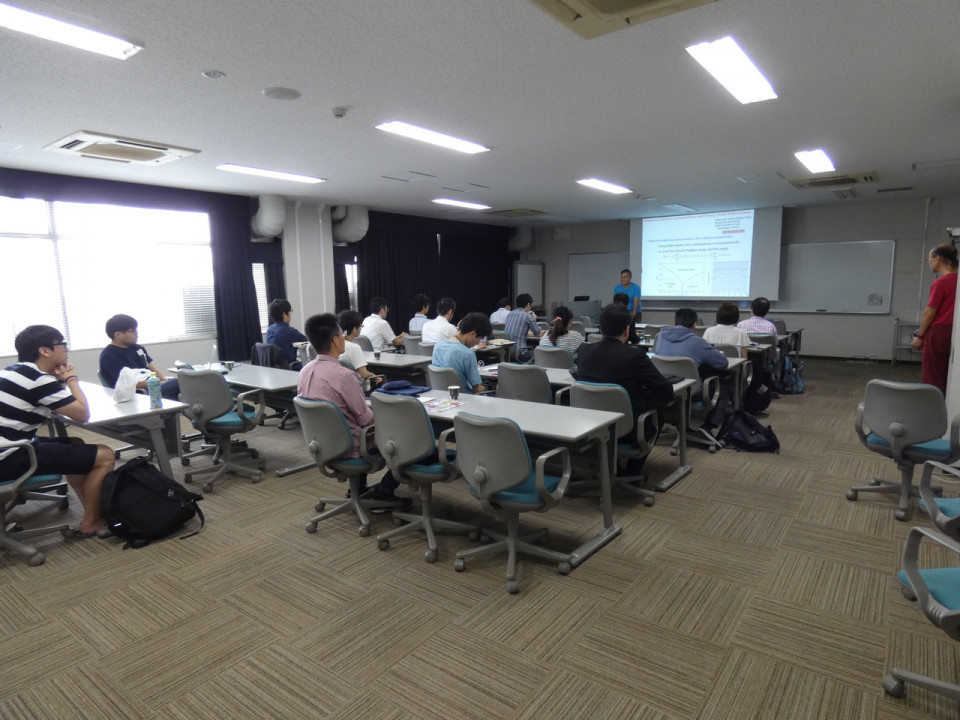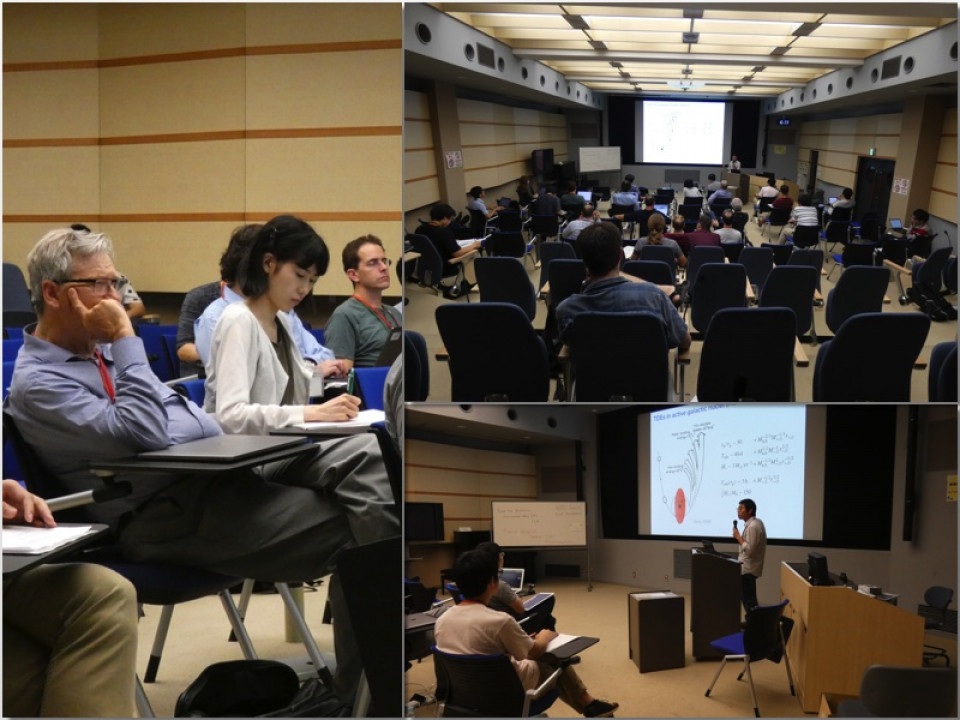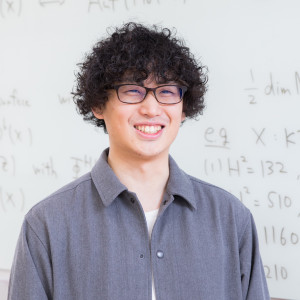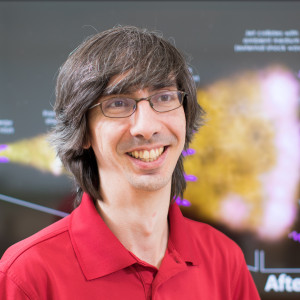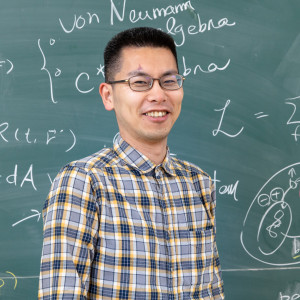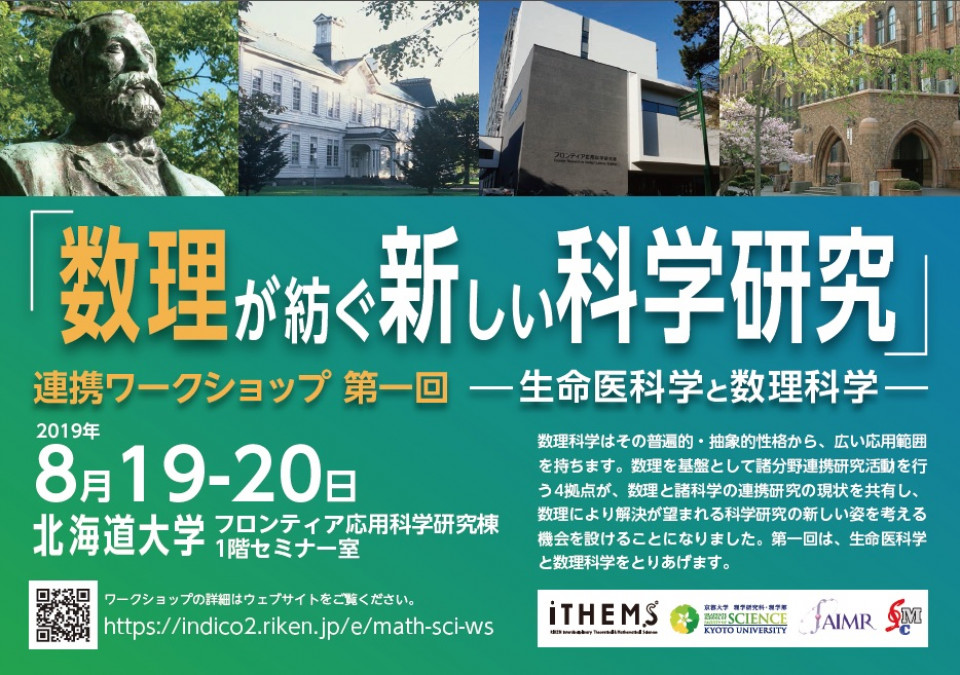Volume 62
Back to Newsletter List
Seminar Report
Report of iTHEMS colloquium - Spacetime Geometry of Black Holes, Wormholes, and Time Machines
2019-07-18
General relativity tells us how spacetime is curved by energy distribution and how matter moves in the spacetime. Classical black hole, which is a solution of the classical Einstein equation, has the event horizon and singularity. Event horizon, from which anything cannot escape, is defined at infinite future, and physical quantities such as energy density diverge at the singularity. These properties are not physically acceptable. Then, what are black holes in our universe? Prof. Pei-Ming Ho (National Taiwan University) addressed this question by studying quantum effects in general relativity. The key is the nature of the vacuum. Classical matter always has positive energy, but in quantum field theory the expectation value of energy density can be negative due to quantum fluctuation of the vacuum. The semi-classical Einstein equation connects the expectation value of energy-momentum tensor to the curvature of spacetime. If there is negative energy, traversable wormhole solutions can be constructed. They could be used as time machines for backward time travel, but they would lead to several paradoxes like “Grandfather paradox”. Prof. Ho explained this topic by showing how SF movies were inconsistent with physical laws. Then, he asked “What are the appropriate energy conditions to avoid inconsistencies?” The answer is still unknown, but it should be related to so-called “information paradox” in black holes. Suppose that a star (classical matter) collapses to a classical black hole. Hawking derived that the black hole evaporates slowly by emitting radiations due to the quantum properties of the vacuum. Then, where has the information of the matter gone after the evaporation? The information seems to disappear because the matter is trapped inside the horizon while the black hole evaporates. Any information must be preserved in quantum theory, but the mechanism is not clear in the black hole evaporation. As he said, one scenario is that some remnant is formed instead of complete evaporation. He first explained that, due to quantum fluctuation of the vacuum, the region near the would-be horizon is modified to obtain a “neck” structure without a horizon. The (proper) volume inside the neck is larger than the usual volume of the 3-dimensional sphere with the radius of the neck (because of negative energy). This is like a SF apartment: when you enter a room, it has a larger space than you expected from the outside. This is one possibility of quantum black holes. He also discussed dynamics of the neck black hole. As it evaporates, the neck would shrink and the information inside the neck would be left as a remnant, but this seems to be not a good solution to the information problem because the information would be isolated from the exterior world forever. Finally, he introduced his recent progress: when a trapping horizon (a local and dynamical notion of horizons) becomes timelike, negative energy occurs and the black-hole mass decreases (not by Hawking radiation). It is a non-perturbative effect w.r.t. Planck constant, which could not exist in the classical limit. This result implies that the four factors are closely related: dynamics near quantum black hole, appropriate energy condition including quantum effects, a more proper description beyond the semi-classical one, and the mechanism of information recovery. His entertaining talk showed that a black hole is not just a hole but a window to a new world. It is time to ask again “What is black hole?”
Spacetime Geometry of Black Holes, Wormholes, and Time Machines
July 2 (Tue) 15:30 - 17:00, 2019
Hot Topic
Summary of the 1-day Workshop on Quantum Gravity
2019-07-18
What is spacetime? In order to discuss this fundamental question, we held "1-day Workshop on Quantum Gravity" on July 4, 2019. The talk was very varied. First, Yokokura introduced a formulation of black holes as a configuration of quantum fields. Next, Prof. Izumi discussed the relation of S-matrix unitarity and renormalizability in higher-derivative theories. After lunch, Prof. Ho developed a general discussion of the relationship between dynamical horizon and negative energy. Prof. Yoneya began with the origin of Nambu dynamics and introduced an attempt to quantize it with a Hamilton-Jacobi method. Prof. Matsuo discussed M-theory and a mathematical structure behind it. Finally, Prof. Kawai developed a simple model of how the weak scale comes out of the Planck scale. In addition, there was more applications than expected, and the room was a little small. However, the discussion in the physically dense venue was very active as if a concert in a small venue had a stronger feeling of live, and it was a wonderful conference where the enthusiasm of the speakers could be felt directly. And the participants were in a wide range of fields such as elementary particles, relativity and mathematical physics, and over a very wide range of generations, including master's first grader and retired professor. In this way, it was also very meaningful that active discussions were conducted across fields and generations. Now is the time to study quantum gravity with free ideas.
1-day Workshop on Quantum Gravity
July 4 (Thu) 9:30 - 18:00, 2019
Hot Topic
RIKEN-OIST mini Workshop 2019 "Mathematical Condensed Matter Physics" was held on July 5-6, 2019
2019-07-15
From July 5 to July 6, RIKEN-OIST mini Workshop 2019, Mathematical Condensed Matter Physics, was held at OIST. We had three excellent lectures and three interesting talks. Prof. Shinobu Hikami gave a lecture about applications of random unitary theory to physics, Dr. Yuta Sekino explained the applications of operator product expansions to non-relativistic theories and Mr. Takuya Furusawa reviewed about dualities in three dimensions. In three talks, Dr. Hidehiko Shimada explained his recent progresses about the four point function in a non-relativistic theory, Dr. Wenliang Li explained recent progresses of conformal blocks, and Mr. Arkaprava Mukherjee reviewed his current achievement. The participants are grateful to the staff of OIST as well as to the iTHEMS assistants for the great help to organize the workshop.
RIKEN-OIST mini Workshop 2019 "Mathematical Condensed Matter Physics"
July 5 (Fri) - 6 (Sat) 2019
Hot Topic
Workshop on Sine-square deformation and related topics 2019
2019-07-18
On July 11th, the workshop entitled "Sine-Square Deformation and related topics 2019," was held at RIKEN Wako Campus. Sine-square deformation (SSD) is a new type of boundary condition at which the coupling constant of the system is spatially modulated. Since its inception, SSD has been studied in various contexts including string theory, condensed matter physics, and quantum field theory. This workshop is the sequel to the workshop previously held at RIKEN two years ago. This time, virtually all the researchers who are actively contributing to the subject attended the workshop.
Workshop on Sine-square deformation and related topics 2019
July 11 (Thu) 10:00 - 18:00, 2019
Upcoming Events
Workshop
Workshop to bring together experts on High Energy Astrophysics from Japan and Israel
July 18 (Thu) - 23 (Tue) 2019
This workshop is co-organized by iTHEMS.
1st week (July 18-19th)
Place: Okochi Hall, RIKEN, Wako, Saitama, Japan
2nd week (July 22-23th)
Place: Integrated Innovation Building (IIB), RIKEN, Kobe, Hyogo, Japan
Venue: Okochi Hall, 1F Laser Science Laboratory, RIKEN / Integrated Innovation Building (IIB), Kobe Campus, RIKEN
Event Official Language: English
Seminar
Introduction to magnitude of metric spaces
July 22 (Mon) 13:00 - 15:00, 2019
Genki Ouchi (Special Postdoctoral Researcher, RIKEN Interdisciplinary Theoretical and Mathematical Sciences Program (iTHEMS))
Leinster introduced the notion of magnitude of a metric space. It is a real number measuring the effective number of points in a metric space. In this talk, I will review generalizations of metric spaces (e.g. asymmetric metric spaces). After that, I would like to talk about the definition, examples and fundamental properties of magnitude.
Venue: Seminar Room #160, 1F Main Research Building, RIKEN
Event Official Language: English
External Event
Interstellar Memes
July 25 (Thu) 20:00 - 21:30, 2019
Don Warren (Research Scientist, RIKEN Interdisciplinary Theoretical and Mathematical Sciences Program (iTHEMS))
Memes are to cultures what genes are to people: ideas, behaviors, or styles that are transmitted within the culture and can propagate or die out. The universe is a big place. How much of it knows about Grumpy Cat? Tale of Genji? Earth?
Cost: JPY1,500 including a drink
Venue: Good Heavens Bar (2F 5-32-5 Daizawa, Setagaya-ku, Tokyo 155-0032)
Event Official Language: English
Workshop
Co-hosted by iTHEMSSUURI-COOL (Kyoto)
RIMS-iTHEMS joint WS on "Math of Jets"
July 29 (Mon) - 31 (Wed) 2019
Co-hosted by RIMS Kyoto University and iTHEMS RIKEN.
Venue: Kyoto University, Main Campus Research Bldg No 15, #201
Event Official Language: Japanese
Seminar
iTHEMS Math Seminar
Complex analysis on a neighborhood of a complex submanifold and its applications
July 30 (Tue) 16:00 - 18:10, 2019
Takayuki Koike (Lecturer, Department of Mathematics, Graduate School of Science, Osaka City University)
Plan of the seminar: we separate each talk into two. In the first 60 minutes the speaker gives an introductory talk for non-mathematicians. After a short break, the second 60 minutes is spent for a bit more detailed talk for mathematicians (working in other areas). We welcome you joining both parts of the seminar or only the first/second half.
Abstract:
We explain our recent study on the complex analytic structure of a small tubular neighborhood of a complex submanifold, which is based on T. Ueda's classification theory. We also explain how to apply them to: (i) a study on (non-) existence of a smooth Hermitian metric on a nef line bundle over a projective manifold with semi-positive curvature, and (ii) a study on non-projective and non-Kummer K3 surfaces.
Venue: Seminar Room #160, 1F Main Research Building, RIKEN
Event Official Language: English
Lecture
SUURI-COOL (Kyushu)
SUURI-COOL (Kyushu) Lecture
July 31 (Wed) - August 2 (Fri) 2019
Takumi Doi (Senior Research Scientist, RIKEN Interdisciplinary Theoretical and Mathematical Sciences Program (iTHEMS) / Senior Research Scientist, Quantum Hadron Physics Laboratory, RIKEN Nishina Center for Accelerator-Based Science (RNC))
SUURI-COOL (Kyushu) at the Ito-campus of Kyushu Univ. will be launched on July 31, 2019. As a first event at SUURI-COOL (Kyushu), the following lecture by Takumi Doi (RIKEN Nishina Center/iTHEMS) will be held. Feel free to join if you will be around Ito-campus.
Nuclei, many-body systems of baryons as protons and neutrons, are ultimately consist of elementary particles of quarks and gluons and their properties are governed by quantum chromodynamics (QCD). Recently, a new theoretical method is developing in lattice QCD, the first-principles calculation of QCD, and the new era is dawning where nuclear physics is constructed directly based on QCD. In this lecture, I first introduce the formulation of lattice QCD.
I will then discuss the theoretical foundation and the latest numerical results about the lattice QCD study of hadron interactions, the key quantities to construct nuclear physics from QCD. I will also give a lecture on computational science, in particular, about supercomputers.
Venue: SUURI-COOL (Kyushu), Ito Campus, Kyushu University
Event Official Language: English
Workshop
Math-Life Workshop
August 19 (Mon) - 20 (Tue) 2019
Organizers
Masaharu Nagayama (MSC, Hokkaido Univ.)
Tetsuo Hatsuda (iTHEMS, RIKEN)
Hiroshi Suito (AIMR, Tohoku Univ.)
Takayuki Sakajyo (SACRA, Kyoto Univ.)
Venue: 1F Seminar Room, Frontier Research in Applied Sciences Building, Hokkaido Univ.
Event Official Language: Japanese
Featured Paper of the Week
The KO-valued spectral flow for skew-adjoint Fredholm operators
2019-07-16
Spectral flow measures the number of eigenvalue crossings of continuous paths of Fredholm operators (which have finite-dimensional kernels). Atiyah, Patodi and Singer first defined spectral flow as a way to study index theory for odd dimensional manifolds.
Recent applications of index theory to topological phases, where anti-linear symmetries may occur, have motivated the study of spectral flow on real Hilbert spaces. The paper develops a theory of spectral flow for skew-adjoint Fredholm operators on real Hilbert spaces, which are a classifying space for KO-theory. Our construction applies to bounded and unbounded Fredholm operators, possibly with additional Clifford symmetries, and generalises all previous notions of analytic spectral flow. The results are also relevant to free-fermionic topological phases, where the topological obstruction to two symmetric Hamiltonians having the same strong topological phase can be exactly measured by the KO-valued spectral flow.
Reference:
Chris Bourne, Alan L. Carey, Matthias Lesch, Adam Rennie
"The KO-valued spectral flow for skew-adjoint Fredholm operators"
doi: 10.1142/S1793525320500557
arXiv: 1907.04981
If you would like to cancel your subscription or change your email address,
please let us know via our contact form.
Copyright © iTHEMS, RIKEN. All rights reserved.


